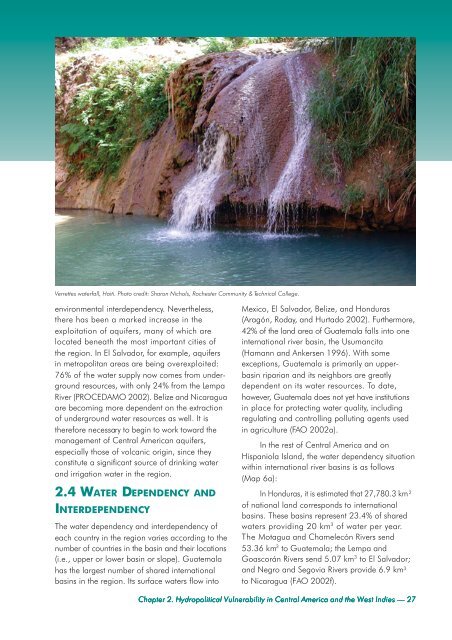Latin America; in English (pdf) - Transboundary Freshwater Dispute ...
Latin America; in English (pdf) - Transboundary Freshwater Dispute ...
Latin America; in English (pdf) - Transboundary Freshwater Dispute ...
You also want an ePaper? Increase the reach of your titles
YUMPU automatically turns print PDFs into web optimized ePapers that Google loves.
Verrettes waterfall, Haiti. Photo credit: Sharon Nichols, Rochester Community & Technical College.<br />
environmental <strong>in</strong>terdependency. Nevertheless,<br />
there has been a marked <strong>in</strong>crease <strong>in</strong> the<br />
exploitation of aquifers, many of which are<br />
located beneath the most important cities of<br />
the region. In El Salvador, for example, aquifers<br />
<strong>in</strong> metropolitan areas are be<strong>in</strong>g overexploited:<br />
76% of the water supply now comes from underground<br />
resources, with only 24% from the Lempa<br />
River (PROCEDAMO 2002). Belize and Nicaragua<br />
are becom<strong>in</strong>g more dependent on the extraction<br />
of underground water resources as well. It is<br />
therefore necessary to beg<strong>in</strong> to work toward the<br />
management of Central <strong>America</strong>n aquifers,<br />
especially those of volcanic orig<strong>in</strong>, s<strong>in</strong>ce they<br />
constitute a significant source of dr<strong>in</strong>k<strong>in</strong>g water<br />
and irrigation water <strong>in</strong> the region.<br />
2.4 WATER DEPENDENCY AND<br />
INTERDEPENDENCY<br />
The water dependency and <strong>in</strong>terdependency of<br />
each country <strong>in</strong> the region varies accord<strong>in</strong>g to the<br />
number of countries <strong>in</strong> the bas<strong>in</strong> and their locations<br />
(i.e., upper or lower bas<strong>in</strong> or slope). Guatemala<br />
has the largest number of shared <strong>in</strong>ternational<br />
bas<strong>in</strong>s <strong>in</strong> the region. Its surface waters flow <strong>in</strong>to<br />
Mexico, El Salvador, Belize, and Honduras<br />
(Aragón, Roday, and Hurtado 2002). Furthermore,<br />
42% of the land area of Guatemala falls <strong>in</strong>to one<br />
<strong>in</strong>ternational river bas<strong>in</strong>, the Usumancita<br />
(Hamann and Ankersen 1996). With some<br />
exceptions, Guatemala is primarily an upperbas<strong>in</strong><br />
riparian and its neighbors are greatly<br />
dependent on its water resources. To date,<br />
however, Guatemala does not yet have <strong>in</strong>stitutions<br />
<strong>in</strong> place for protect<strong>in</strong>g water quality, <strong>in</strong>clud<strong>in</strong>g<br />
regulat<strong>in</strong>g and controll<strong>in</strong>g pollut<strong>in</strong>g agents used<br />
<strong>in</strong> agriculture (FAO 2002a).<br />
In the rest of Central <strong>America</strong> and on<br />
Hispaniola Island, the water dependency situation<br />
with<strong>in</strong> <strong>in</strong>ternational river bas<strong>in</strong>s is as follows<br />
(Map 6a):<br />
In Honduras, it is estimated that 27,780.3 km 2<br />
of national land corresponds to <strong>in</strong>ternational<br />
bas<strong>in</strong>s. These bas<strong>in</strong>s represent 23.4% of shared<br />
waters provid<strong>in</strong>g 20 km 3 of water per year.<br />
The Motagua and Chamelecón Rivers send<br />
53.36 km 3 to Guatemala; the Lempa and<br />
Goascorán Rivers send 5.07 km 3 to El Salvador;<br />
and Negro and Segovia Rivers provide 6.9 km 3<br />
to Nicaragua (FAO 2002f).<br />
Chapter 2. Hydropolitical Vulnerability <strong>in</strong> Central <strong>America</strong> and the West Indies — 27
















